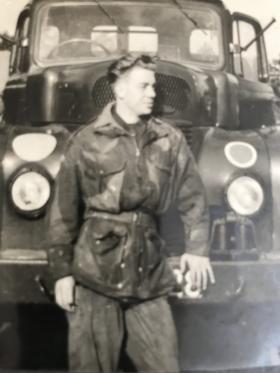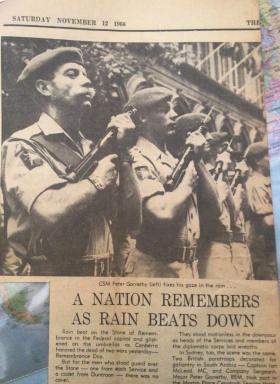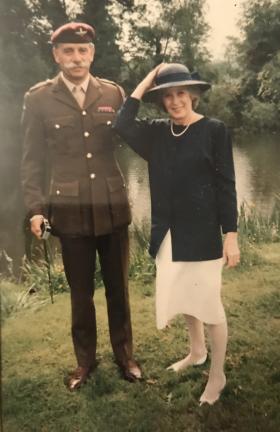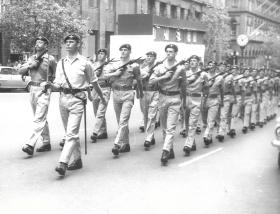Lieutenant Colonel Peter Andrew Geraghty MBE BEM served in the Parachute Regiment in all ranks from private to lieutenant colonel between 1954 and 1991 and in many parts of the world, including active service in Malaya, Radfan and Northern Ireland.
The Radfan is a wild and rugged mountainous area some 70 miles to the north of Aden in present day Yemen and inhabited by fierce and tough tribes, who traditionally had carried out raids against travelers in the region as a means of economic security. In 1964, the area was under the Aden Federal Government, protected by the United Kingdom. A communist inspired rebellion against the royalist government in Yemen to the north had resulted in a civil war, which had increasingly influenced Arab nationalist movements in the region and encouraged the Radfan tribes to increase their attacks on the Dhala road which connected Aden with Yemen. By April 1964, the Federal Government considered that the area was now beyond the control of their own forces and asked for support from the British to restore order. The initial phase of the operation was carried out by British troops already stationed in Aden, but it was soon evident that further reinforcements were needed from elsewhere in the region and from UK. 3rd Battalion, The Parachute Regiment (3 Para) was stationed in Bahrain in the Gulf at the time, providing a deterrent against an Iraqi invasion of Kuwait, but was ordered to Aden in early May, leaving two of its four rifle companies in Bahrain.
3 Para, under the command of Lieutenant Colonel Anthony Farrar-Hockley (later General Sir), was quickly in action, clearing ridges, peaks and valleys and establishing government control. It was not an easy task as there were no roads in the mountains, few supporting helicopters, and extremes of temperature. Maps of the area were almost non-existent and communications difficult. Peter Geraghty was Signal Sergeant of the Battalion faced with the responsibility of ensuring that the radio nets functioned effectively in this demanding environment. It took the Battalion two weeks to advance 10 miles in enemy held, mountainous territory, crossing steep sided ravines and fighting several actions supported by artillery and ground attack aircraft. All supplies had to be carried forward by one of the companies acting as fighting porters, each man carrying over 100lbs. The Battalion was finally ordered to occupy the Wadi Dhubsan, which was an important enemy stronghold. This was occupied after a perilous descent of over 3000 feet by night followed by a fierce battle for control of the valley. Geraghty’s exemplary conduct during this operation earned him the award of the British Empire Medal (BEM), which was even more remarkable as few awards were made as a result of this campaign. His citation stated that he “was employed with the foremost echelon of battalion headquarters through the period of operation. Frequently responsible for the organization and running of the battalion net, he improvised with exceptional skill to maintain the extended battalion group net. Under fire, he set a high example of coolness and devotion to duty, inspiring the radio operators with his resolution.”
Peter Andrew Geraghty was born on 13 February 1936 in Darnley, North Yorkshire, the son of John and Edith Geraghty. His father was ex Irish Guards who joined the police when he left the army but died during his police service resulting in Peter and his three sisters being admitted to St George’s House Northern Police Orphanage in Harrogate, which he entered in March 1943. Leaving St Georges at 16, he briefly took up an apprenticeship with a local plumbing firm before joining the British Army just before his eighteenth birthday in January 1954, enlisting in The Parachute Regiment. After training, he was posted to the 3rd Battalion, but he soon was selected for the Independent Parachute Squadron to work alongside the SAS for service in the emergency in Malaya, which was a guerrilla campaign by communist independence forces against British rule that had started in 1948. 22 SAS had been involved in the campaign since 1950, which represented the rebirth of that regiment after World War 2. In 1954, the SAS required a reinforcement squadron, and the Parachute Regiment was invited to provide personnel. About 80 all ranks were selected and after preparatory jungle training, the squadron joined the SAS for operations and was formally assimilated into the SAS regimental structure as The Parachute Regiment Squadron (22 Special Air Service Regiment), although they retained their red berets and Parachute Regiment cap badges. Peter Geraghty was the youngest member of the Squadron and was employed as a signaller, a vital role due to the long operational distances. The Squadron patrols penetrated deep jungle by foot, helicopter insertion and parachute drop, carrying a variety of weapons and two week’s rations and resupplied by air drop. The Squadron spent most of 1955 patrolling in southern Malaya and the State of Selangor, with the task of gaining information, the destruction of enemy camps and terrorist bands, the rescue of oppressed tribesmen who lived deep in the jungle and forcing the terrorists to the fringe areas of the jungle where they could be mopped up by conventional security forces. Most of the following year was spent in the mountainous area between Ipoh and the Cameron Highland. He was injured in January 1956 when a 3-ton truck he was travelling in overturned but returned to duty after a short period of treatment. In April 1957, the operational tour of the Squadron expired, and it was disbanded, its personnel were returned to UK and returned to their parent units. Geraghty was posted back to 3 Para, at which time he met his future wife Aileen Mitchell, who was a great support to him throughout his service.
He soon became a sergeant and was the Signal Sergeant when the Battalion was ordered to the Radfan in 1964. He progressed to Warrant Officer and in 1966, when the Battalion was sent to Australia to take part in a training exercise in north Queensland with an Australian brigade that was preparing for service in Vietnam, he was selected to be the sergeant-major of an honour guard from the Battalion which that year took the place of the Australian Army for the Remembrance Day Parade in Sydney. He also appeared on a popular TV programme. Promoted again he became the Regimental Sergeant Major of the Parachute Logistic Regiment before returning to 3 Para in that appointment, which included a difficult tour of duty in Northern Ireland. He was commissioned in February 1974 and over the next 17 years progressed to become one of the few men commissioned from the ranks to reach the rank of lieutenant colonel. He served in various appointments in the Depot of the Parachute Regiment, the Junior Parachute Company, the School of Infantry Brecon and in 2 Para and 3 Para. His outstanding time as the Quartermaster of 3 Para, which included a tour in Belize, resulted in him being made a Member of the Order of The British Empire (MBE) for “his outstanding example of diligence, ability and good-humoured leadership despite many difficulties and an unusually eventful two years.”
He retired in early 1991, but his talents were not lost to the Army, as he was employed as a civilian staff officer at the Royal Military Academy Sandhurst for the next ten years, where he was responsible for the management of sport and estates. This was fitting as sport had been a great love throughout his life, particularly golf, which he continued to enjoy until ill health overtook him. He took up golf as a young sergeant, when a knee injury from a parachuting accident, caused a medical officer to recommend that he avoided the more ‘violent’ sports.
He continued to take a strong interest in Regimental affairs, including a term as President of the Winchester Branch of the Parachute Regiment Association. He is remembered for his ‘unflappable’ approach in all circumstances and his ability to teach and delegate to his subordinates. He had a very dry sense of humour, a sense of mischief and fun and was always immaculately turned out; his distinguishing feature being his ever-present luxurious moustache.
He died in Aldershot on 13 December 2022 from complications arising from Parkinson’s Disease. A devoted family man, he was predeceased by his wife Aileen, and is survived by son Simon and daughter Beverley, who is married to former Parachute Regiment officer Mike Mitchell.
Click here to read a personal account by Peter Geraghty.
Created with material kindly donated by Ian Mcleod.
Read More







Latest Comments
There are currently no comments for this content.
Add Comment
In order to add comments you must be registered with ParaData.
If you are currently a ParaData member please login.
If you are not currently a ParaData member but wish to get involved please register.